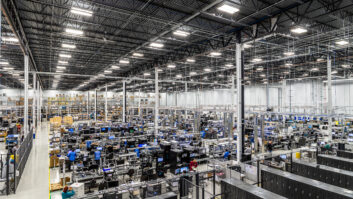It was, said cinema owners, unfair. The studios and distributors would get all the benefit from digital cinema – but the cinemas were expected to pay substantial sums for the equipment that would enable it to become a reality. “But,” replied the studios and distributors, “with digital cinema systems, you’ll be able to show much more than just Hollywood movies. You can become a multipurpose entertainment centre – and think of how much money that will make you!”
The cinema owners didn’t buy that argument, and continued to resist. It wasn’t until agreement on the so-called Virtual Print Fee – in effect an arrangement that saw distributors contribute to the cost – that D-Cinema began to achieve momentum and mass.
The discussion on what the future of cinemas might hold did, however, increase the focus on two areas that had historically not received much attention. One area was what became known as ‘alternative content’ – anything that could be shown on a screen, but that wasn’t a Hollywood movie. The other was the concept of ‘e-cinema’ – the use of electronic projection and audio technology to deliver that alternative content. Ten years on from the first digital cinema installation, what happened?
Before looking at e-cinema, it’s important to distinguish it from digital cinema. D-Cinema is defined as digital exhibition systems, designed to deliver the highest presentation quality and security, and that meet the requirements of the Digital Cinema Initiative, formed in 2002 by the major US studios. Only DCI-compliant equipment can be used to show Hollywood movies.
And e-cinema? “It’s every other form of cinema,” smiles Nancy Fares, business manager for DLP Cinema at Texas Instruments. “It’s not controlled or constrained by the high standards set by the DCI,” adds Richard Nye, senior sales director at Christie Digital. “Any digital cinema presentation system that falls outside the DCI recommendations can be classified as e-cinema.”
In other words, an e-cinema system can be any digital projector, any screen, any kind of sound system and any kind of source material. As such, it is all too easily looked down on as being inferior. And if the question is ‘Will I get an on-screen image that rivals what I would get in the cinema?’ – yes, it is inferior. That, though, is not the point – and many of today’s e-cinema installations can deliver on-screen shows that will more than satisfy audiences.
“E-cinema technical requirements are certainly simpler and less expensive than D-Cinema,” notes David DesRoches, director of product management for digital cinema at Dolby Laboratories. “Content such as MPEG-2 clips can be created using commonly available desktop tools. Encryption isn’t required, and expectations of the projection quality are lower.”
But the point is that e-cinema inhabits an alternative, often parallel, universe that is little or nothing to do with showing the latest Hollywood blockbuster on a giant screen.
“Our first real activity in e-cinema started around 10 years ago with digital onscreen advertising at cinemas in Norway,” says Nye. “This introduced the concept of digital projection to projectionists and exhibitors. Until this time, all projection in cinema was either 35mm for main features and national advertising, or 35mm slides for local advertising.”
Global reach
But e-cinema can be more than a simple adjunct to the ‘main’ projector. E-cinema is a thriving market – in many areas – in its own right. In India, for example, there are substantial e-cinema networks. In July, the UK Film Council announced a £1.2 million pilot scheme to equip rural cinemas with e-cinema systems. Norwegian projector manufacturer projectiondesign has seen substantial success in e-cinema in Scandinavia, with installations running into the hundreds – some with screens as wide as 24m.
“An entire D-Cinema system can cost well over $200,000,” says Trond Solvold, the company’s products and applications manager, “while a good e-cinema system including the projector, satellite receiver, PC and so on costs around 30% of that.”
On the other hand, the growth of D-Cinema is having an impact. “Several e-cinema networks have been wound up and any serious circuit/exhibitor will need to take the D-Cinema route,” says David Hancock, senior analyst and head of film and cinema at market research firm Screen Digest. “D-Cinema is replacing the universality of 35mm. It’s true that, in the US, events are often still played out on e-cinema equipment, but that’s because the screen advertising companies have digital networks in place and they’re providing such events.”
In fact, the number of e-cinema installations in the US has reached thousands. It is a business that continues to be worthy of attention from many suppliers. “Technicolor focuses on e-cinema for digital screen advertising services and related long-form content,” notes Curt Behlmer, executive vice president of Technicolor Creative Services, “but the majority of our business, and all services for major US studios, are D-Cinema focused.”
The fact is that anything an e-cinema system can do, a D-Cinema system can do also. For major cinema chains, the justification for installing both doesn’t exist – although there are exceptions.
“Some exhibitors want to consolidate presentations on one system to save the costs of buying and maintaining separate equipment,” notes DesRoches. “Others want to save the more expensive lamp hours on the D-Cinema projector for features and keep a smaller system for preshow or e-cinema.”
“Whether a cinema can show alternative content is totally dependent on whether or not the D-Cinema system is configured with a scaler box to convert the e-cinema content to a format that is compatible with the D-Cinema projector,” says Nye. “However, more recently with the addition of support for HDCP and HD sources such as Blu-ray, you can plug a 1080p signal directly into the projector.”
Behlmer concurs. “The ability to support alternative content via existing digital cinema systems is often dependent on the additional components added to the system by the integrator in order to scale content appropriately to ensure a positive viewing experience,” he says. “The challenge in integrated systems supporting alternative content and digital cinema is the underlying economics as alternative content providers must pay a usage, or Virtual Print Fee, similar to those fees paid by other studios and content providers. In addition, forms of content beyond feature films are expected to ultimately create more competition for bookings and screen time.”
Widening appeal
“A D-Cinema system can accept any input you care to throw at it, as long as it has the right decoding and processing capabilities,” echoes Hancock. “It will even show a PowerPoint presentation.”
When it comes to content, there can be little that is more ‘alternative’ to a major Hollywood movie than a PowerPoint presentation. From the cinema owner’s point of view, the goal is to keep seat occupancy at the maximum. One way of doing that is to turn the cinema into a conference facility – where the requirement to be able to show PowerPoint slides is, of course, mandatory…
“The challenge is to fill empty cinemas during the daytime and to make the cinema complex an attractive competitor to traditional conference centres and hotels,” says Solvold, “as well as to have the possibility of showing world-class events to a broader public.”
World-class events such as, for example, New York’s Metropolitan Opera, which last season – its fourth, so far as its engagement with digital cinema is concerned – saw 11 performances shown in 800 cinemas worldwide, gathering revenues close to $40 million. Rock concerts, comedy shows and sports events are becoming increasingly commonplace attractions at cinemas. Recently, NCM broadcast the Michael Jackson memorial service to selected movie theatres.
And speaking of Michael Jackson… “Digital cinema has clearly opened new doors for exhibitors,” says Behlmer. “For example, the recent bidding by Sony Pictures Entertainment to acquire the Michael Jackson This Is It tour rehearsal footage from AEG is a perfect example of content that may not have been released to the public in a theatrical setting without digital cinema-enabled theatres.”
“Alternative content is growing in popularity, particularly in the US,” says Fares, “although there is still some way to go before it can be considered mainstream. Film remains the primary content for cinemas. However, alternative content does offer the opportunity to show content outside peak operating hours, which opens the doors for additional revenue.”
“A complex today might only have one screen able to receive these alternative content events, as frequency and attendance is not yet high enough to fill every auditorium,” says DesRoches. “We don’t have specific numbers, but alternative content in theatres is growing in scope and scale each month and is a viable business for exhibitors already.”
Behlmer holds the same view. “Alternative content is not yet providing a significant revenue increase for the movie theatres,” he says, “but it is being used as a way to bring new audiences to the venue as well as to fill seats on weeknights.”
Hancock agrees: “The promise is there, but it’s early days for this sector. Revenues are small, but will increase as the screen base increases.”
Pursuing profit
The movie industry has traditionally thrived on being able to deliver entertainment experiences that consumers can’t get at home – and as home entertainment systems become more capable of delivering high-quality video and audio, the bar continues to be raised, putting cinema revenues under pressure and forcing the movie industry to become increasingly inventive. That’s happening with alternative content, just as it’s happening with 3D. But which will have the greater positive impact on the profitability of cinema owners?
As ever, the influence and muscle of the Hollywood studios should not be underestimated. “3D box-office revenues are generally up to three times higher than the equivalent 2D box-office revenues,” says Nye. “All the major studios are committing to 3D content being released. For example, Pixar has announced that all future animated/CGI movies will be released in 3D as well as 2D.”
“3D is the major driver of digital cinema equipment and increased box office right now,” notes DesRoches. 3D is an experience not yet truly available in the home, and still not widely available in cinemas – a point not lost on him.
“Once digital 3D screen counts start to stabilise,” he continues, “the novelty will become commonplace, and all digital theatres will have at least one 3D screen. The situation is still years away, but then I think you will start to see those exhibitors savvy enough to exploit the equipment for alternative means being more successful. Exhibitors that can book unique content in their theatres that appeals to a local demographic and fills seats during periods when feature content might not be in demand are sure to do well.”
“Alternative content presents the opportunity for a valuable additional revenue stream for cinemas,” adds Fares, “but it is not a key market driver at the moment. In the future, we can expect to see more alternative content in 3D – and it’s likely to become a more attractive offering for cinema-goers.”
The future of alternative content being shown in cinemas, then, looks assured. But what of e-cinema? It unquestionably has its place, and will continue to do so – but that place will continue to dwindle in size. “The march of D-Cinema is inexorable,” says Hancock. “Around 10% of all screens worldwide are now D-Cinema screens – rising to up to 20% in the US, UK and France. The debate about D-Cinema and e-cinema has moved on.”
There is no doubt, then, that showing movies will continue to be the raison d’être of cinemas. Whether it’s e-cinema or D-Cinema, however, digital video and audio technology are transforming what’s possible: the time can’t be far away when the cinema without a satellite dish on its roof will be as uncommon as the cinema without a popcorn stand.







